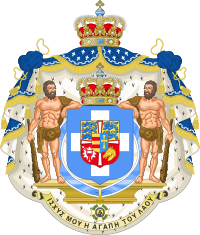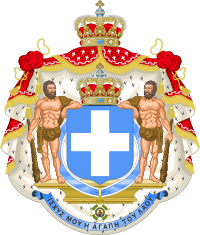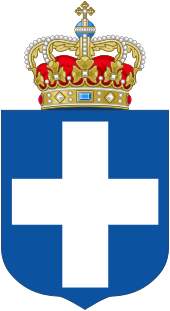- Coat of arms of the Kingdom of Greece
-
The coat of arms of the Kingdom of Greece was the official symbol of the Greek state during the period of the monarchy (1832–1924 and 1935–1973).
Contents
Description of the coat of arms of the Wittelsbach dynasty
The coat of arms was based on that of the Kingdom of Bavaria, and consisted of a shield bearing the Greek national emblem of a white cross on a blue background, topped by a royal crown and supported by two crowned lions rampant. At the centre of the cross lay an escutcheon bearing the characteristic lozenge pattern of Bavaria, as a symbol of the House of Wittelsbach.
This emblem was used during the reign of King Otto I, from 1832 to his exile in 1862.
Description of the coat of arms of the Glücksburg dynasty
After Otto's fall, the young Prince William of Denmark was chosen as king, and the new coat of arms bears a strong resemblance to that of the Danish Royal Family. The central feature of the coat of arms remained a shield bearing the Greek national emblem of a white cross on a blue background. At the centre of the cross lies a shield with the dynastic arms of the Schleswig-Holstein-Sonderburg-Glücksburg family. The shield is topped with a crown and supported by two male figures, depicting the legendary Hercules.[1] The ribbon and medal of the Order of the Redeemer are suspended from the shield. The banner at the bottom bears the dynasty's motto, Ἰσχύς μου ἡ ἀγάπη τοῦ λαοῦ ("People's love, my strength").
This emblem appeared on coins of the Kingdom, and official documents from at least 1880 until 1973, except for the period of the Second Hellenic Republic (1924–1935), and continues to be used by the former Greek Royal Family.
Variants
Coat of Arms Date Description 
1863–1924 The coat of arms under the Glücksburg dynasty, created in 1863, used in the kingdom until 1924, when King George II was exiled. 
1863–1973 Also created in 1863, used as a simplified version of the main royal coat of arms. Features the light blue cross couped of Greece, without the arms of the Glücksburg dynasty. 
1936–1973 Created in 1936, after the restoration of the monarchy, in use until 1967, when King Constantine II was exiled, and then nominally until 1973 when the kingdom was replaced by the Hellenic "Republic". The arms remains in use by the former Greek Royal Family. See also
Notes
- ^ From the latter, royalists in Greece were sometimes mockingly called "Ηρακλείδες" ("the Herculeses").
Categories:- Coats of arms of former countries
- Greek coats of arms
- National symbols of Greece
- Greek monarchy
Wikimedia Foundation. 2010.


